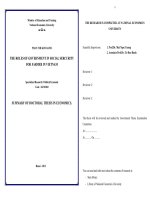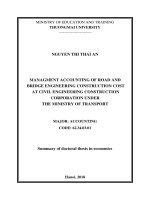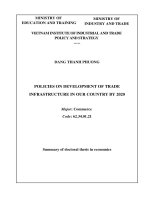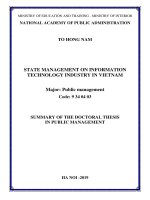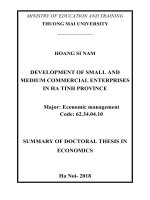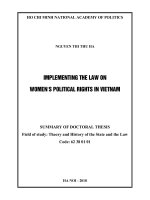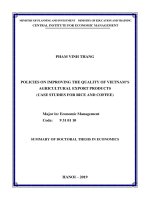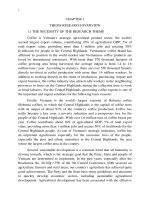Summary of Doctoral thesis in Economics: Policies on development of trade infrastructure in our country by 2020
Bạn đang xem bản rút gọn của tài liệu. Xem và tải ngay bản đầy đủ của tài liệu tại đây (474.51 KB, 29 trang )
MINISTRY OF
EDUCATION AND TRAINING
MINISTRY OF
INDUSTRY AND TRADE
VIETNAM INSTITUTE OF INDUSTRIAL AND TRADE
POLICY AND STRATEGY
=
DANG THANH PHUONG
POLICIES ON DEVELOPMENT OF TRADE
INFRASTRUCTURE IN OUR COUNTRY BY 2020
Major: Commerce
Code: 62.34.01.21
Summary of doctoral thesis in economics
The thesis is completed at Vietnam Institute ofIndustrial and Trade
Policy and Strategy
Scientific supervisors:
Prof., Doc. Do Duc Binh
Doc. Vo Van Quyen
Prof. , Dr. Do Duc Binh
Dr. Vo Van Quyen
Reviewer 1:
……………………………………………...
Reviewer 2:
……………………………………………...
Reviewer 3:
……………………………………………...
Thesis will be defended in front of Committee of Vietnam Institute
of Industrial and Trade Policy and Strategy
At …. hour …., day …. month …. year …..
The thesis can be found at: National Library
Library of Vietnam Institute of Industrial
and Trade Policy and Strategy
3
INTRODUCTION
1. Rationale of the thesis
Trade is the basic stage of reproduction, link of production and
consumption. Trade growth is a manifestation of a prosperous
economy. The convenient and modern infrastructure is a prerequisite
for smooth trading, production development. Trade infrastructure (TI)
includes: Trade infrastructure (TI) for import and export; TI for
wholesale; TI for retail; TI for trade promotion. In Vietnam, TI has
formed naturally, quite completely, met basic production and
consumption demands. However, there have been inappropriate points
which the main reasons is the state policies on the development of the
trade infrastructure have limitations. The Government, Ministries,
localities have cared about formulating and implementing policies.
However, policieson development of trade infrastructure has much
limitationsnegatively affecting the development of TI, mainly policies
on developing each type of TI whereas not many policies on developing
TI as a whole body of TI in links with each other. Meanwhile, naturally
connecting types which form TI, the establishment of new TI…
requires a solution to improve policies. Besides, the type of TI which
are the traditional market, supermarket, trade center (TC) have been
and still occupy large numbers, directly affect the life and business of
people and companies with the important role of Logistics Center.
From the need of research as mentioned above, the thesis topic was
selected for research.
2. Objective and mission of the research
Objective of the research: to further clarify the scientific basis of the
proposal for complete policieson developing TI in Vietnam by 2025
and orientation to 2030.
Mission of the research: to systematize, clarify the theory of the State
policies on developement of TI; evaluate the actual situation of
contents, progress of policies on development of TI; propose opinions,
4
solutions to complete policies on national development of TI by 2025,
orientation to 2030.
3. Object and scope of the research
Objective of the research: the State policies on development of TI.
Scope of the research:As for spatial dimension: in Vietnam.
As for time dimension: Analyzing the real situation in 20032016
period and proposing policies recommendations by 2025, orientation to
2030.
As for content: Analyzing the State policieson development of TI, in
which the content, process of policies are focused. Traditional TI with
the market (retail, wholesale) and modern TI with the supermarket, TCs
are prioritized in analyzing policies on development. TI for service
mainly is logistics centre. Due to limitations of thesis length and
capacity of collecting information, for in line with first scope as
mentioning to visible TI, PhD. student did not mention electric trade as
a main content.
4. Research method
Method of dialectical materialism, historical materialism, systematic
method. Sociology method, survey method, interview method,
observation method, method of analysis, of document analysis.
5. Contributions of the thesis
Academic contributions: The thesis has systematized, supplemented
and clarified the theory of policies on development of TI (contents,
process of policies), studied experiences of countries on policies on
developing TI, had lessons for Vietnam.
Practical contributions: The thesis has generalized the real situation of
Vietnam’s policies on development of TI from 2003 to 2016; evaluated
the results, limitations and causes in content and process of policies on
development of TI.
The thesis has brought views, orientations and solutions, proposals for
complete content and process of policies on development of TI
5
generally and policies on development of specific Tis particularly by
2025 and orientation to 2030.
6. Structure of the thesis
Apart from prescribed parts, thesis includes following main contents:
Chapter 1: Theoretical base and practical experience in policies on
development of trade infrastructure
Chapter 2: The real situation of Vietnam’s policies on development of
trade infrastructure
Chapter 3: Viewpoints and solutions to complete and improve
Vietnam's policieson development of trade infrastructure by 2025 with
orientation to 2030
LITERATURE REVIEW OF RESEARCH PROJECTS
RELATED TO THE THESIS TOPIC
1. The group of scientific works refers to theoretical issues
This group mainly mentions concepts, contents, methods, analytical
models, policiesevaluation in general and policies on development of
TI in particular, includes 09 typical works.
2. The group of scientific works mentions the experiences of
developing TI of countries, includes 05works.
3. The group of scientific works refers to the current state of policy
and developing TI in our countryincludes 07 works. Besides, there
are some books, scientific papers on the real situation of developing
markets, supermarkets, TCs in general.
4. A space in science and research direction for the thesis
The definition of TI has not been understood clearly,
comprehensively, clarified the unity of its definitions.
The policy on development of TI in Vietnam is analyzed in a field
relating to one type of TI or in a limited spatial domain with no
generalization, evaluation of policies on developing general TI which
have association among TI types.
The policy on development of TI is often mentioned in the form of a
listing and a qualitative assessment.
6
In both theory and practice, process of policies on development of TI
has not been detailed and generalized.
Therefore, the chosen content for further study is analyzing policies on
development of TI generally, the link betweenTI for retail (market,
supermarket, TC) and TI for wholesale (wholesale market, terminal
market) and TI for exports ( Logistics Center).
Phd. Student has also tried to usesurvey method, interview and
statistical analysis method to illustrate evaluation on policies on
development of TI in Vietnam recently. The domestic and international
scientific works is such very good references. However, the study
"Policy on development of trade infrastructure in our country until
2020" is affirmed to not identical with the published research.
CHAPTER 1. THEORETICAL BASE AND PRACTICAL
EXPERIENCE IN POLICY ON DEVELOPMENT OF TRADE
INFRASTRUCTURE
1.1. DEFINITION, CLASSIFICATION, CONTENT AND ROLE OF
POLICY ON DEVELOPMENT OF TRADE
INFRASTRUCTURE
1.1.1. Definition of policyon development of trade infrastrucutre
1.1.1.1. Definition of trade infrastructure
a) Infrastructure is a specific part of technical material foundations in
the national economy with basic functions and tasks whichensure the
general necessary conditions for the production and reproductive
expansion processtake place normally; the overall material, technical
and architectural background for socioeconomic activities take place
normally.
b) Trade infrastructure Trade is an independent economic sector, with
the function of commodity circulation, providing services to society
through profitable sales. Trade is the basic stage of reproduction,
production consumption links, also known as circulation.
TI is the whole of typical works for trade activities taking place in a
safe, convenient, quick and effective way.
7
Characteristics of TI: To be uniform, synchronous, to create a solid
body, ensuring the strength, system and link. In each type of TI,
independent components are relatively related, ensuring effective
service; (ii) small to largescale TI works, mainly outdoors, nationwide;
(iii) is an important part of the economic infrastructure, production and
consumption link in the country, internationally.
Classification: TI for retail; TI for wholesale; TI for import and
export; TI for trade promotion.
The mainrole and function of TI:+Market is the place where trading
activities between producers, traders and consumers happen and the
place: (i) consumpting output, input supply; reflecting market signals,
consumer demand; orientation, promotion of production, reproduction;
(ii) consuming and supplying goods, orientation, promotion of
consumption. The function is directly centralizing services: Buying,
selling, forming market prices, controlling quality and creating value
for goods; Trade promotion, market access; Additional services,
business support.
+ Supermarket: is a selfservice store, selling items that meet daily
consumption demands, with an owner; a modern retail TI style
connecting production and consumption more deeply than the market.
Supermarkets have the main function as markets, but develop more
with better service, price list, clear origin.
+Trade center: is a modern type of TI, larger than supermarkets, more
complex than of booths, independent retail outlets. Goods are owned by
the company/ shop owner; there are works in service of trade and
entertainment activities; Multifunctional TI.
+ Logistics Center: is the direct place to provide logistics services,
organized by logistics service providers. Store function, loading,
unloading, dividing goods; create value added logistics; optimal
storage; The role is to reduce time of goods flow in the supply chain,
reduce costs, improve the efficiency and competitiveness of logistics
enterprises, complete the quality of services.
8
1.1.1.2. Developing trade infrastructure
It is the change and mobilization from the incompletion to the
completion of TI, solvesproblems of TI, reduces negative factors,
inherits and raises the positive factors of TI.
It is a process taking place based on the width (growth in the number
of TIs) and depth (changes in the quality of TI in a good, modern and
more appropriate way to the needs of the users).
The content of developing TI includes: developing TI quality growth
generally, developing industrialization and modernization TI
contributes to trade business and competitiveness capacity of trade
businesses; balanced, harmonious, effective development of trade
business types, sustainable TI development.
Indicators assessing the development of types of TI: (i) Growth in the
number of each type; The number of types of TIs; The quantity of
goods and services supplied by the TIs; (ii) Modernization of facilities;
An increase in the quality of goods and services provided at TIs;
(iii)Population and average radius of TIs.
Trend of modern development of TI: TI developed from tradition to
modernity, especially in the context of increasingly developed science and
technology has impacted this trend. That is the establishment of new
commercial business methods, distinct from the traditional way. Since then,
infrastructure to serve trade business methods must also have its own
characteristics.
1.1.1.3. Definition of policy on development of trade infrastructure
Policies on development of TI is overall the State’s viewpoints,
objectives, principles, tools and measures used to orient, guide,
organize, encourage the development of TI in a given period of time.
1.1.2. Classifyingpolicy on development of trade infrastructure
Classification by agency enact policy: Central, Local agency.
Classification by time: shortterm, mediumterm and longterm policy.
9
Classification by type of TI:cmarket development policy, supermarket
development, TC development, logistics center development, exhibition
center development, ...
Classification bycontent: preferential policy, policy on investment
support for TI; policy on management of TI.
Classification bytools: credit policy, tax, planning, land policy, policy
on economic and technical standards,..
Classification bythe target audience / scope of the policy.
1.1.3. Content of policy on development of trade infrastructure
1.1.3.1. Content, form and layout
The content of the policy on development of TI addresses actual
problems of current TI and in development orientation; mentions one of
two main areas; TI state management and investment TI promotion;
shows the will, attitude of the State towards the issue in the
development of TI. The written form includes laws, ordinances,
decrees, decisions and circulars of ministries and interministries. Each
policy includes objectives of policy and problemsolving solutions for
developing TI, main tool is the economy; administrative organization;
propaganda, education; technique and profession.
1.1.3.2. Process of policies on development of trade infrastructure
The process of public policy is generalized in three periods which are
formulation, implementation and evaluation policy.Each policy of
developingTI also follows the above procedure.
The first period is formulating policies on development of TI
Formulating policies on development ofTI is the whole process of
studying, formulating, promulgating a policy on development of TI.
The subject formulating are: the subject of policy making; the subject
comment on policyformulating; the subject determines the policy.
The cycle includes: (i) Identification of policy issues; (ii) drafting
policy options; (iii) policy design; (iv) Promulgate policies.
The second period is implementing policy on development of TI:
Implementing policieson development of TI is after the formulation
10
period. At that time, the policy on development of TI has been passed
to the executive branch for implementation.
Subjects implementing are: Government and the State management
agencies on development of TI; Businesses investing in TI, business
men and consumers.
The cycle includes: formulatingplans of policy implementation;
Disseminating policy; Assigning,coordinating the implementation of
policy; Implementingpolicy; Maintaining, adjusting policy; monitoring,
inspecting, urging the implementation of policy.
The third period is monitoring and evaluating policies: Evaluating the
results of implementing policies on development of TI; Understand the
level of policies achieving goals; reasons of success and failure. This
period is carried out continuously during the time of maintaining
policies, evaluating the whole / whole policies, with the subject as state
agencies and implementing policies of developing TI.
1.1.4.Role of policies on development of TI
Orientation of activities of subjects related to TI.
Supporting a mechanism to encourage socioeconomic entities to
voluntarily participate in business investment and development of TI.
Creating a favorable environment for the development of TI.
Regulating the activities of TI.
1.2. REQUIREMENTS, CRITERIA AND IMPACT FACTORS
FOR EVALUATING POLICIES ON DEVELOPMENT OF TI
1.2.1.Requirements of policies on development of TI
Clearly and consistencydefined policy objectives.
Ensuring that the policy is systematic, synchronous and uniform
Matching modern, open socioeconomic development trend.
Ensuring the policy conforms to characteristics of the type of TI.
1.2.2. Criteria for assessing policies on development of TI
1.2.2.1. Group of criteria to evaluate the content of policies on
development of TI
(i) The validity of the policy; (ii) The effectiveness of the policy.
11
(iii) The fairness of the policy; (iv) The results of the policy.
(v) Level of solving problem of policy.
1.2.2.2. Group of criteria to evaluate the process of policies on
development of TI
The viability and validity of policies
The level of crystallization of policies on developing TI
The level of united transparency of decisions on implementing
policies on developing TI.
Skills to organize the implementation of policy on development of TI
of the State agencies and employers.
Ability to mobilize other subjects’ participation in the promulgation
and implementation of the policy on development of TI.
The efficiency of propaganda and education on TIs development.
1.2.3. Factors influencing policies on development of TI
1.2.3.1. Subjective factor
The environemnt of implementing policies on developing TI includes
political, technological, socio economic and international
environments.
Capacity of investors in TI and participation of businessman, residents
in process of policies on developing TI.
1.2.3.2. Objectivefactor
Awareness of definitions, roles of TI and policies on developing TI.
Capacity of mobilization, usage of resources and other policy tools.
The nature of the policy issue.
1.3. EXPERIENCES ON POLICIESOF DEVELOPING TI OF
SOME COUNTRIES, LEARNED LESSONS FOR VIETNAM
1.3.1. Experiences of some countries on the policy of developing TI
Regarding investment capital mobilization, use for developing TI
Regarding support based on lands
Regarding the use of planning tools
Regarding the use of economictechnical standard tools
Other development policies
12
1.3.2. Learned lessons for Vietnam
Applied lesson: (i) The need for measures to curb domestic shortterm
speculative capital inflows; (ii) Encouraging foreign investors for long
term investment and reinvest in the country. Attracting capital in the
form of PPP; (iii) Building a harmonized planning for developing TI.
Learned lessons about developing wholesale markets/ markets for
agricultural products; supermarket development; information,
communication support in formulation, implementation of policy for
development of TI.
Learned lessons: Land Use Policy; In the process of policies on
developing TI in Vietnam, appropriate methods should be selected.
CHAPTER 2. THE REAL SITUATION OF VIETNAM’SPOLICY
ON DEVELOPING TRADE INFRASTRUCTURE
2.1. OVERVIEW OF DEVELOPMENT OF TI IN VIETNAM
2.1.1. Overview of developing TI in Vietnam in recent time
Because of deeply cared, TI in Vietnam has been widely distributed,
diversified in terms of type, quantity growth, quality improvement,
more modern and civilized. The number of markets increased from
7,676 markets (2005) to 8,528 in 2010, 8,660 in 2015 and 8,513 in
2016. Supermarkets and TCs are increasingly popular, from 385
supermarkets (2015) to 571 supermarkets (2010), 799 supermarkets
(2015) and 869 supermarkets (2016). The number of TCs has raised
from 72 TCs in 2008 to 101 TCs in 2010 and 174 TCs in 2015 and 170
TCs in 2016. The number of Logistics Center increased from 6 TT
(2012) to over 10 TT (2016), 20 Fair Centers; commercial warehouses
and the rapid development of electric infrastructure.
2.1.2. Real situation of some main trade infrastructures
2.1.2.1. Market’s situation
The number 3rd rank markets takes largest, the proportion of total
markets decreased, following by 2nd rankmarkets‘ quantity with a slight
rise, and 1st rank markets with small quantities but increase in
13
proportion. The number of preferential markets for agricultural
products (AP) raised, from 35 markets (2014) to 94 markets in 2016.
The network of markets has developed widely, disributed
equally.Retail markets make up for 86.8%. Wholesaleretail market
(12.7%). Wholesale markets (0.5%) are often those for AP.
+ General market accounts for 99.1%.
+ The market network has developed in a more solid and modern way,
but there are differences between regions.By 2015, nearly 50% of the
market is semisolid. The solidand temporary markets accounted for
28.5% and 25.3%. The 1st rank markets have the best facilities. The
infrastructure of the markets’network for AP is better than the market
network in general.
In 2015, there areaverage0.78 markets/communes, wards, towns. The
average service radius is 3.49 km/ 1 market. One market serves average
10,590 people, falls by 2005 (10,760 people).
2.1.2.2. Real situation of supermarket development
The number of supermarkets has increased steadily over years, in
2016, there were 869 supermarkets. The Red River Delta, the South
East, the North Central and Central Coasts have a high proportions,
mainly located in cities.
In 2011, general supermarkets accounted for 49.7%, specialized
supermarkets(41.9%),unclassified (8,4%). The 3rd rank supermarkets
was over 50%, the 2nd rank ones(30%), the 1st rank ones (20%).
The average service area was from 518.7 km2/ supermarket in 2010 to
434.3 km2/supermarket in 2015. Average service radius was from 13.58
km2/supermarket to 11.48 km2/supermarket. In 2015, the averageserved
population was 119,000 people/supermarket.
2.1.2.3. Real situation of TC development
Quantity: The number of TCs raised from 101 (2010) to 174 (2015)
and 170 (2016). TCs are mainlyin the Red River Delta and the South
East area. Remaining areas account for 15% to less than 10%.
Due to unclear identification, the classification of TCs based
oncriteria in Regulation 1371 was not implemented in most localities.
14
2.1.2.4. Real situation of Logistics Center
The number of Logistics Center has increased from 06 in 2012 to over
10 in 2016. They are mainly at the business and provincial level,located
in the South, then in the North and Central.
Through the strong development of TI in 20032016 period, it can be
said that TI has been developed to meet the basic demand for goods
circulation. However, there are limitations from the state policies.
2.2. CURRENT SITUATION OF POLICIES ON
DEVELOPMENT OF TI IN VIETNAM
PhD student used qualitative and quantitative method to assess the current
situation of content and process of policy on development of TI. Qualitative
tool was use to compare the change of policy objects when having impact
policies; to identify the strengths and weaknesses of the content, process,
policy tools in evalution of general policies formulation and Logistics Center
development policies. Quantitative tools use the Likert scale for survey
through questionnaires to assess the policy objects of the content and process
of policies on development of TI; the level of satisfaction with quantity and
quality of TI. Results illustrate the analysis of the actual content, process of
policies on development of TI.
The thesis handles 02 forms of questionnaire, including:(i) questionnaire
collecting opinions of the State management officers, experts and staffs
of the Association; (ii) opinion poll for users of TI in Hanoi, Ho Chi
Minh. The thesis has interviews with some investors / managers of
markets, supermarkets, TCs.
Sampling: With sample 1, nonrandom sampling method. With
sample 2, a single random sampling method.
Sample size: For sample 1, the sample size is 65 votes, using the
formula: n = 5*m, n is the sample size and m is the number of
independent questions. There are 13 questions. In fact, the number of
votes: 80, collected 60 votes, reaching 75%.
For sample 2, the element is consumers, the overall research is
consumers (aged 15 and above) in Hanoi and Ho Chi Minh, about 8
15
million people in 2015. Formula for calculating the sample size: n = z 2 .
=> The sample size is: n = 1,96 2 x
= 385. In fact, the total
number of votes is: 400, collected362 votes, reaching 90.5%.
2.2.1. Real situation of the process of policies on developing TI
The policy development process of TI in Vietnam involves: (i) in the
central level: the MIT (directly the Planning and General Department
and the Domestic Market Department); (ii) provinces/ cities under the
Central Government: Department of Industry and Trade (Department of
Trade Management); (iii) district, town: District People's Committee
(Economic/ Infrastructure Division/ Industry and Commerce).
Coordination of responsibilities is of the Ministry and relevant
departments. Basic policy formulating and implementing steps like the
theory framework in Chapter 1. In practical, in the past till 2015,
formulation of policies on development of TI was in line with law on the
Promulgation of Legal Documents in 2008. On June 22, 2015, the
National Assembly passed the Law on Promulgation of Legal
Documents (Law of 2015), basically renewing the construction process.
The process of drafting laws, ordinances, decrees and resolutions of
People's Council in provinces and building policies is separated.
Formulating policies on development of TI is in this direction. Two
examples are proposing amendments to the Trade Law 2005 and
proposing to amend Decree 02 on markets were implemented in steps
such as the policy impact assessment report; Report on the
implementation of laws relating summary report, acceptance of
comments; photographs of comments; Draft outline of the Decree.
Activities for gathering comments, policy reviews have been
implemented. The process of formulating policies has been adjusted,
similar to other countries, from the bottom up. The ministry is in charge
of drafting the policy, consulting ministries, agencies, related
components, businesses and other components.
According to the analysis of survey data, most of assessments on the
effectiveness of the implementation of policies on developing TI are
16
generally at a low level, 3 points. It is the Feasibility and Effectiveness
of policies, the level of united transparency of implementation policy
decisions, the quality of government staff implementing policy, the
level of propaganda, education of policies, and participation of social
classes in the implementation of policies on development of TI. Some
indicators have the average point less than 3, namely, the economic
effectiveness of the Policy, the Level of policy implementation, the
mobilization of resources and the Use of policy tools of state
management agencies. Collected interviews show that enterprises have
easy and timely access to policies through dispatch, internet, press
release and newspapers.
Implementing policies on development of some types mainly markets,
supermarkets, TCs, most indicators have the average point of 3. In all three
categories, the level of policy materalization and the level of united
transparency of policy implementation decisions were assessed positively,
reaching 33.1 points. The implementation of policies on TCs development
was evaluated better, most indicators were from 3 to 3.2 points.
Mobilization of resources and the use of policies tools by state
management and participation of different social classes in policy
implementation, with all three types were evaluated at low point, under 3.
Communication performance and education policies on development of
Markets and ST were 2.8 points. Involvement of the social classes in
implementation of policies ondevelopment markets was low, at 2.6 points.
2.2.2. Real situation of the content of policies on development of TI
First, the content of policies on development of TI has been
institutionalized inline with the Party’s guideline. The role of TI is
recognizedmore clearly in terms of guideline, broader in terms of type,
and more detailed in terms of policy, shown in the Resolutions of
the Communist Party of Vietnam:
Resolution No.12NQ/TW on1996/03/01 of the Politburo "On
continuing to renovate the organization and operation of trade, develop
the market in the socialist orientation".
17
The policy on development of TI is stated in the Resolution of the
9thNational Party Congress.
Resolution of the 5thPlenum of the Party Central Committee, Session
IX on acceleration of agricultural, rural industrialization and
modernization in the 20012010 period.
Resolution No. 08/NQTW on 2007/02/05, the 4th Plenum of the X
Party Central Committee on major guidelines, policies for a fast,
sustainable economic development when Vietnam as WTO member.
Resolution No. 26/NQTW on2008/05/08 in the 7 th conference of the
X Party Central Committee on agriculture, farmers, rural areas.
Resolution No. 13NQ/TW, 2012/01/16, the 4thConference, the XI
Party Central Committee, orientation to develop main types of TIs
including markets; distribution, wholesale centers; types of
convenience, specialized stores; supermarkets, TCs; exhibitions.
Institutionalizing the Party’s guideline on development of TI, since
1996, the legal framework for developing TIhas been improved step by
step. The State has enacted legal documents related law. The
Government and Ministries have enacted legal documents under
law.According to content division, policies on developing TI in
Vietnam include (i) investment promotion with preferential investment
policies capital support policies from state budget; (ii) and state
management policies.
Second, some indicators assessing content quality of policies on
developing TI. According to survey data, relating content quality of
policies on developing TI generally, indicators evaluated positively are
the adequacy, omprehensiveness of policies (3,2 points). The
synchronization, unity of constituent elements of policies (3,1 points)
and the stability of policies (3,1 points), while some indicators
evaluated under average (under 3 points) are the appropriation, the
practicality of policies (2,9 points), the update of policies (2,8 points).
Content quality of policies on main types development which are markets,
supermarkets and TCs showed through survey data: The synchronization,
unity of constituent elements of policies and the appropriation, the
18
practicality of policies were evaluated positively, from 3 3,1 points. The
stability of policies on markets, supermarkets development were evaluated
at average level (3 points). Indicators assessing content policy of 3 types
were under average, from 2,7 to 2,9 points. It can be seen that the content
of policies on developing TI has limitations.
2.2.3 Real situation of investment encouragement policy on
developing TI
2.2.3.1. Promotion policy
There are barely general incentives policy for investment in developing
TI, only some regulations on incentives for investors developing TI in
rural , dificult areas. Specifically: Decision No.92/2009/QDTTg on
2009/07/08 on credit incentives for trade businesses in difficult areas,
with specific principles the maximum loan, interest rate, deadline for
regular trade businesses in difficlut areas adapting conditions in Article
5 of this decision. These businesses are allowed to lendVietnam Bank
for Social Policies to meet capital needs for trade including: (i)
Investment in building agencies, stores, warehouses, equipments and
other legacies; (ii) Purchasing goods including machines, equiments,
materials, raw materials, consumer goods and other chattels on market;
(iii) Joining capital with other individuals, organizations to carry out
production programs, businesses in difficult areas. Decision No.23/QD
TTg on 2010/01/06approved by the Prime Minister for the project
"Rural Trade Development in the 20102015 period and orientation to
2020": Investment programs on infrastructures in rural areas are applied
promotion policy in Decree No.108/2006/NDCP on 2006/09/22 of
detailed principles and instructions to implementation investment
policies, state credit loan for investment based on Decree
No.151/2006/NDCP on 2006/12/20of credit investment and credit
exports of the State and Decree No.106/2008/NDCP on 2008/19/09
(replaced by Decree No.75/2011/NDCP on 2011/30/08 of credit
investment and credit exports of the State).
Till now, investment incentive policy for some typical types of TI.
According to the Government's Decree No.51/1999 /NDCP on
19
1999/07/08, investment in constructing supermarkets is on the list of
branches, domains that is eligible for investment preferences. Then, in
the Government Decree No.35/2002/NDCP on 2002/03/29, investment
in construction, development of supermarkets was excluded from the
investment incentives list.
According to Decree No.108/2006/NDCP on 2006/09/22 (Decree
108/2006), trade projects in difficult, very difficult areas are entitled to
preferential investment policyas other branches ‘ones when investing in
the same area. This Decree’s encouragement, investment incentives
apply to 1st rank markets and exhibition centers.
Next, documents specialized the policy were promulgated: Decree No.
151/2006/NDCP on 2006/12/20; and Decree No. 54 /05/2013); Decree
No. 114/2009/NDCP on 2009/12/23, amending and supplementing
articles of Decree No.02/2003/NDCPon 2003/01/14; Decision
No.23/QDTTg on 2010/01/06approved by the Prime Minister for the
project "Rural Trade Development in the 20102015 period and
orientation to 2020"Decree No.61/2010/NDCP on2010/04/06 to
encourage enterprises to invest in agriculture and rural areas (replaced
by Decree No.210/2013 /NDCP on 2013/06/19).Decision No.482/QD
TTg dated 2010/14/4 stipulating mechanisms and policies to encourage
the development of border markets.On November 26, 2014, the
National Assembly promulgated the Investment Law No.
67/2014/QH13. The Government promulgated Decree No.
118/2015/CP on 2006/09/22; To abolish: (i) List of geographical areas
eligible for enterprise income tax incentives, issued with the
Government's Decree No.218/2013/NDCP on 2013/12/26; (ii) List of
sectors eligible for import tax incentives, attached to the Government's
Decree No.87/2010/NDCP on 2010/08/13; Clause 4 of Article 19 and
the “list of geographical areas entitled to land rent preferences shall
apply only to geographical areas with specific administrative
boundaries” in Clause 3, Article 19 of Decree No.46/2014/NDCP
on2014/05/15 of the Government.
20
According to Decree 118/2015, investment, construction and
management, market business in rural areas are of the special
investment incentiveslist; exhibitions, logistics center, commodity
store, supermarket, TC are included in the investment privileges list.
2.2.3.2. Capital support policy of state budget
The capital for developing TI from the state budget shall be used
mainly for market development according to Decree No. 02/2003/ND
CP on 2003/01/14; For mountainous,remote areas, there are support
investment policies under the programs 135, 120 and 160; Decree
No.114/2009/NDCPQ; Decision 60/2010/QDTTg regulates the
allocation of state budget for transitional infrastructure works.
People's committees of provinces, cities under central authority
promulgate specific mechanisms, policies to support the development
of TIin their localities. Materalization the Party’s guideline in
Resolution 12/NQTW, programs have been built and carried out.
However, up to now, there have been no specific legal documents
regulating the mechanism for establishing the position, the power of
regulating the market for ST, TCs as well as handling the relationship
between traditional and modern TI. In the 2005 Commercial Law,
except for the Commercial Exchange mentioned as a specific type of
TI, only trade fairs, exhibitions, and logistics services such as
commercial activities have not been mentioned. as a trade activities but
not mentioned the role as a type of TI; There is no provision in the Law
on TI as policies on management, development, support and planning.
2.2.4 Real situation of management policies on development of TI
2.2.4.1.Planning policy
Planning is an important tool for managing the development of TI.
Regulations on planning have been concretized by the following
documents: Decree 92/2006/NDCP on 2006/09/07approved by the
Government on the formulation, approval and management of the
master plan for socioeconomic development (Decree 92/2006). Decree
No.04/NDCP on 2008/01/11, amending and supplementing articles of
Decree No.92/2006 (ND 04/2008). Guiding circulars include: Circular
21
No.01/2007/TTBKH on 2007/02/07 of the Ministry of Planning and
Investment (MPI) guides implementing articles of Decree
No.92/2006/NDCP; Circular No.03/2008/TTBKH on2008/01/07 of
the MPI guides implementing articles of Decree No.04/2008/ND
CP.Then, replacing for two above circulars, on 2013/10/31, the Ministry
of Planning and Investment enacted Circular No. 05/2013/TTBKHTT
guiding the establishment, appraisal, approval, adjustment and publication
the master plan for socioeconomic development; Major sectorial, domain
and product planning in accordance with Decree 92/2006 and Decree
04/2008. All previous regulations contrary to this Circular are hereby
annulled.Most recently, the Planning Law was approved by the National
Assembly XIV on November 24, 2017. The Ministry of Industry and
Trade (MIT) also enacts regulations on planning.
2.2.4.2 Policy on economictechnical standards: Criteria for identifying
and classifying types of markets mentioned in Decree No.02/2003/NDCP
on 2003/01/14; with mountainous, dificult areas, and Decree No.
114/2009/NDCP on 2009/12/23 amended and supplemented articles of
Decree No.02/2003/NDCP. The criteria for the market are included in
recommended standard in TCVN 9211: 2012 Market Design standard.
With supermarkets and TCs, only the supermarket, TC regulationwas
promulgated in Decision No. 1371/2004/QDBTM on2004/4/29 of
theMIT. Logistics Center are divided into levels in Decision No. 1012 on
2015/07/03 approvved by Prime Minister. There are barely identities and
specific criteria for other types of TI.
2.2.4.3. Policy on management model The state management of
markets and models of organizingmarket management are specified in
Article 13 Decree No.02/2003/NDCP.
Business organizations, individuals violating shall be handled
according to the provisions of law.
2.2.4.4. ENT policy: Since 2007, Viet Nam has legally committed itself
to specific, quantitative and transparent ENT policy. Till now, FDI
enterprises have set up retail establishmentsapart from the first retail
establishments with an area of less than 500 m2 in areas planned for
22
goods purchase and sale and finsihed constructing infrastructure must
not follow ENT regulations.
2.3. ANALYSIS OF THE REAL SITUATION OF POLICY ON
DEVELOPMENT OF TI THROUGH SURVEY DATA
2.3.1.Appropriate points of policies on development of TI
The process of policies on development of TI has been
improved.Important policies are more scientifically proven, initially to
create and improve policies on development of TI in accordance with
the requirements of state management practice and the development of
the industry of TI. Policies meet basic requirements of development,
responding to the impact of global economic crisis. Ministries, sectors,
local authorities, agencies are aware of the importance and
responsibility in implementing process. The implementation of policies
meets basic requirements of local characteristics, characteristics of
policy beneficiaries.
Review of policy implementation has begun to be noticed.
Policy analysis and evaluation has begun to attract attention.
Appropriate points of policies on development of TI: policies have
been step by step promulgated, supplemented and amended in line with
the State management requirements in the market economy. The legal
environment is formed in a relativelty synchronious manner, creating
conditions for domestic and foreign economic sectors to invest to
develop TI .The management of TI business activities has been
strengthened. Preferential policies, incentives and investment support
positively impact on TI.
The progress in management policies on development of TI through
policy tools: The formulation of development of TI is concerned;
Criteria for identifying some types of TI are issued; The statistics and
information dissemination on TI shall be implemented.
For promotionpolicies on developing TI, it can be seen some
progress. Economic sectors participate actively in trade investment and
business. The encouragement policy achieves positive results. The
23
socialization policy is clear and convincing. Economic sectors joining
in investment markets are diverse. Effective participation of FDI
enterprises in the development of TI
The policy of developing TI has had a positive impact on quantity
and quality of TI network.
2.3.2. The inadequacy of the policy on development of TI
The inadequacies in formulating policy for development of TI
+ The limitedinvolvement of affected objects in formulatingpolicy.
+ Formulating policy on development of TI was not comprehensive.
+ The process of making policy of developing TI was still closed.
+ Limited involvement in policy formulation.
+ Formulation policy on developing TI has not kept up with the
country's integration recently.
+ Limitations in assessingimpact of prepromulgated policyin VN.
Shortcomings in the implementation of policy on developing TI
+ The policy of developing TI is not synchronous.
+ The content of some policies is not close to reality, not timely.
+ The contents of guiding documents are unclear and unanimous.
+ The content was not based on firm legal framework.
The inadequacies of somepolicies on developing specific TI:policy
on TI socialization; on renovation of old, downgraded market to
marketTC; on ENT; on technical, economic standards.
The development of the network of TI has limitations in terms of
quality of goods, services, facilities, mainly the network of markets.
2.3.3. Cause of inadequacies
Insufficient awareness on TI role and the necessity of policy.
Political factors in the process of deciding to invest in TI.
The shortcomings of the government's determination
Weaknesses in mobilizing resources, exchanging information,
coordinating and using policy tools.
Participation of objects affecting by policies on developing TI.
Limitations of the capacity of the enterprises investing in TI.
24
Some other specific policy causes.
CHAPTER 3. VIEWPOINTS AND SOLUTIONS TO COMPLETE
VIETNAM’S POLICIES ON DEVELOPMENT OF TRADE
INFRASTRUCTURE BY 2025, ORIENTATION TO 2030
3.1. FORECAST OF FACTORS AFFECTING POLICIES ON
DEVELOPING TRADE INFRASTRUCTURE
3.1.1. Forecast of objective factors
Leadership of the Party in opinions, orientations for policies on
development of TI is close, decisive in the coming period.
The capacity of mobilization and use resources for policy process will
be more completed.
The nature of policy issues are more diverse, complicated.
3.1.2. Forecast of subjective factors
Environment for implementation, formulation of policies: The
economic and political environment are stable to improve investment
efficiency. Population and living standard of population in Viet
Namchanges in quantity, age and distribution; an increase in average
income, income gap; a reduction of household size; Forecasts on
production industriesaffects the development orientation of TI;
Advances in technology: The 4th Industrial Revolution changes the
producing way affecting the way people live, work. International
commitments are implementedThe international commitments on
developing TI is implemented.
Participation of companies, reisdents in the process of policies.
Factors above are forecasted to change production, allocation,
consumption trend in Vietnam. Since then, TI has been changed to
develop following new requirements to complete policies.
3.2. OPINIONS TO COMPLETE THE POLICY ON
DEVELOPMENT OF TRADE INFRASTRUCTURE
Mentioned contents of policy on developingTI is comprehensive and
has positive impact on creating a reasonableNTIin terms of quantity,
25
structure, quality, modernity, economic, social and political efficiency,
environment, food hygiene and domestic, foreign affairs.
Completing the process of policy on developing TI must go with
country and sector’s socioeconomic development objectives.
Completing the policy is one of activities boostingtrade operation.
Completing the policy on development of TI must ensure the
participation of the State management agencies and other subjects.
Completing the policy must ensure the exploitation of
advantages,abide general principles, fulfill interests, obligations of
international organizations which Vietnam has joined and committed in
the FTAs.
3.3. SOLUTIONS FOR COMPLETINGPOLICIESON
DEVELOPMENT OF TRADE INFRASTRUCTURE
3.3.1. Completing the process of formulating policies
Clearly identifyingexact existingproblemwhile developing TI and
appropriate awareness to content of policies on developing TI.
Process of policies on developing TI requires participation.
Complete the mechanism for appraising and approving TI
development policies
Improving the quality and effectiveness of process TI development
policies.
Close coordination between ministries and sectors.
Learning international experiences.
Increasing propaganda policies.
Maintaining monitoring and supervision after the implementation
policies on development of TI to ensure the accuracy, validity and
efficiency of policies.
3.3.2. Improving the capacity to implement the policy on
development of trade infrastructure
Improving the capacity of employees formulating and implementing
policies on development of TI.
